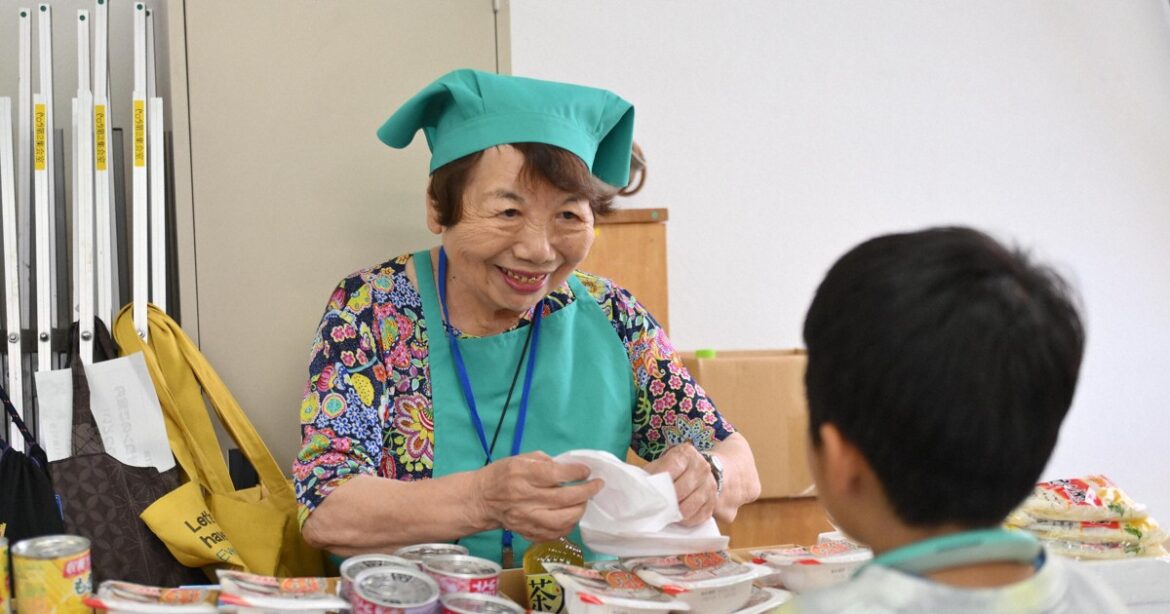HIRAKATA, Osaka — Yoko Mori, a survivor of the 1945 U.S. atomic bombing of Hiroshima, runs a children’s cafeteria in Osaka Prefecture while providing testimony on her bombing experience.
“I don’t want my children and grandchildren to go through the same experience,” Mori, 85, recently told the Mainichi Shimbun. A resident of Hirakata, Osaka Prefecture, Mori has devoted herself to activities to support children in her community while leading a group of A-bomb survivors residing in the city.
Mori was 5 years old when she was exposed to the atomic bomb at her home in Hiroshima’s Kusunokicho district (now part of the city’s Nishi Ward) on the morning of Aug. 6, 1945, about 1.8 kilometers from the bomb’s hypocenter. Her father had been sent to war, and Mori, her mother and five siblings were trapped under their house that collapsed due to the blast.
Everyone, however, was safe as they fit into the gap under a ceiling that fell diagonally. Outside, other houses in the neighborhood had also been flattened. Mori heard people groaning from under the rubble, saying, “Help!” People who were burned all over were wandering about with their melted skin hanging off their bodies, looking like ghosts.
Mori stepped barefoot over corpses lying on the ground. People who had managed to reach the riverside in search of water were found dead, piled on top of one another. “It was like a living hell. The sight was beyond description,” she recounted.
Her family headed to her father’s parental home in northern Hiroshima Prefecture on foot. As dusk fell, they spent a night in a settlement along the way. At a home that provided them shelter, her family was offered rice water for supper, with only a few grains of rice contained in it. She could even see her own face reflected in the bowl. Still, she appreciated the kindness of the residents. “How hard it must have been to take care of others when everyone was struggling to secure food,” she reflected.
After arriving at her father’s parents’ home, her family built a shack by the river and lived there. With no electricity or water, they caught around 10 fireflies and put them in a bottle, using it as a makeshift lamp.
Her bombing experience always cast a shadow over her life thereafter. She was bullied at her elementary school, with her classmates saying, “Here comes pikadon (an onomatopoeia expressing the flash and the blast of the atomic bomb). We will get infected (with radiation). Run off!”
After graduating from junior high school, she relocated to Osaka as part of a group employment program. She broke up with her fiance due to her being an A-bomb survivor. She eventually married and had two children, but was recognized as a sufferer of an A-bomb-related disease in 1982 after developing a thyroid disease. She still has to see a doctor and is constantly worried that the effects from the bomb’s radiation may affect her children.
Her testimonial activities have continued since 2015, when she was approached about chairing the local A-bomb survivors’ group. Meanwhile, she has been running a children’s cafeteria once a month in Hirakata since 2018 after learning about children’s poverty in the news. “I couldn’t believe it was something that’s happening in Japan today, that there are children who are too poor to eat,” she recalled.
The cafeteria has welcomed not only children but also elderly locals living alone. “Come back here again,” Mori calls out to children while wearing an apron and a triangular headscarf. Her memory of the rice water she had after the bombing and the people who supported her when she was struggling with hunger crosses her mind. “I’m where I am because I received their support. Even if I cannot return the favor directly to those who helped me, I wish I could repay them in some way,” she said.
(Japanese original by Kana Nemoto, Osaka City News Department)
99,130 holders of A-bomb survivor’s certificates
As of the end of March 2025, the number of holders of atomic bomb survivor’s certificates totaled 99,130, falling below 100,000 for the first time since the issuance system began. This is just over a quarter of the peak number of 372,264 recorded in fiscal 1980. The average age of certificate holders stood at 86.13 years. By prefecture, Hiroshima had the highest number at 48,310, followed by Nagasaki at 23,543, Fukuoka at 3,957, Tokyo at 3,307 and Osaka at 3,186. Yamagata Prefecture had the fewest, with six holders. There were also 2,178 “overseas hibakusha” — A-bomb survivors who returned to their home countries or emigrated abroad after the war.


AloJapan.com